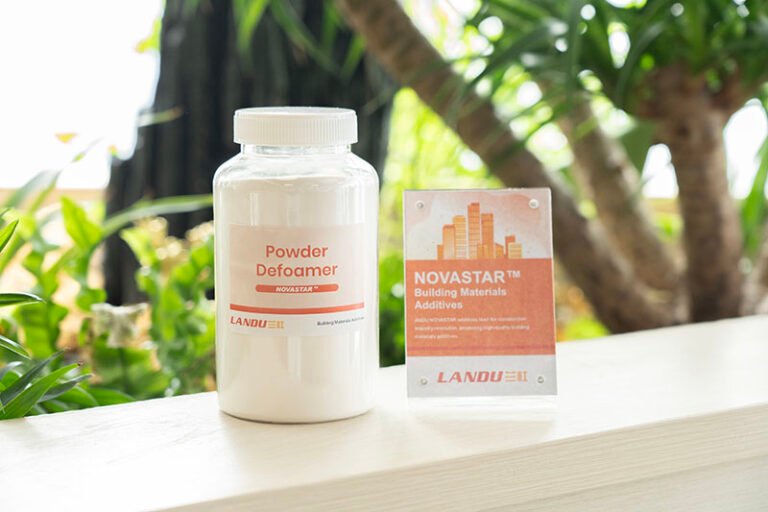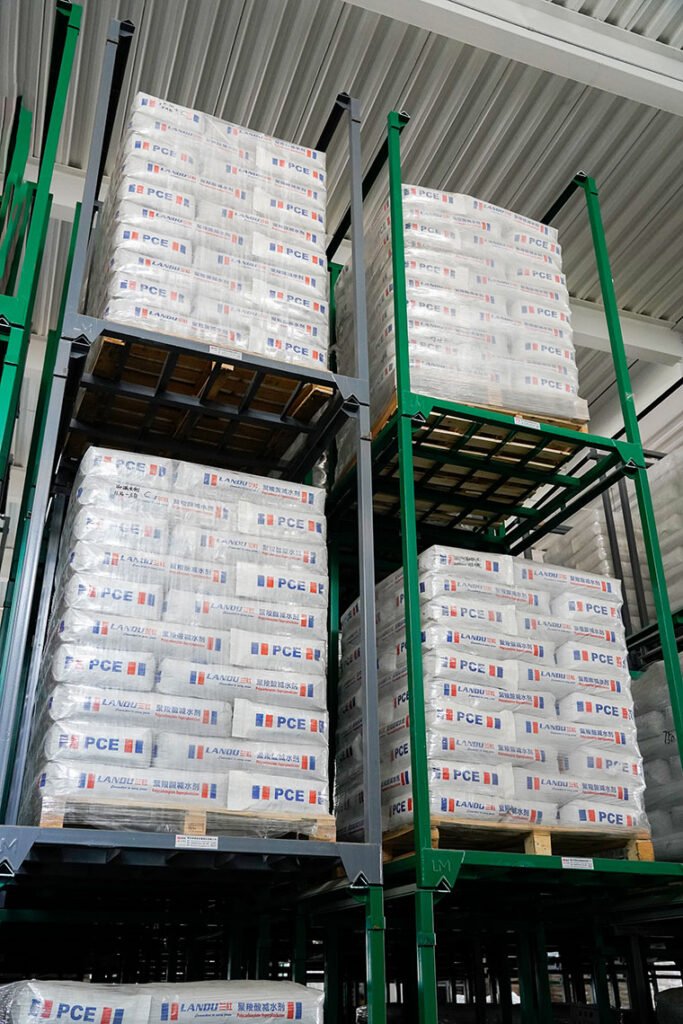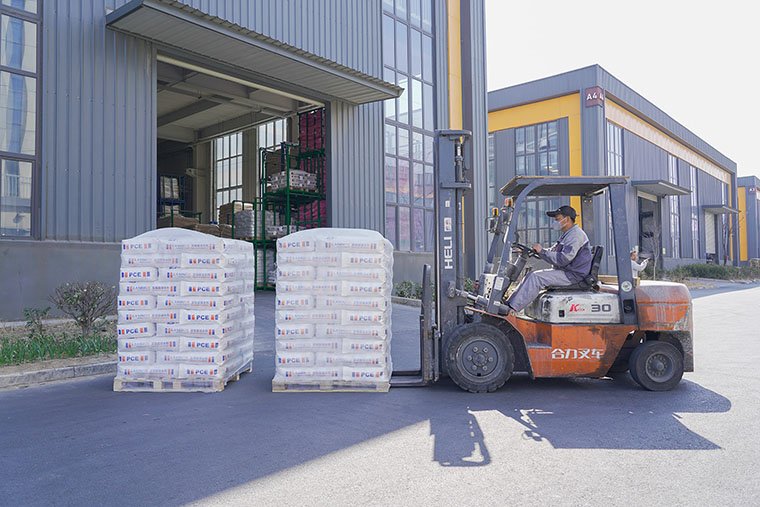5) Blending framework: standard elements and brackets
Each facility and region varies, yet the subsequent setup offers a functional initial blueprint for binder-based tile bonding agents.
Core elements
- Binder: 20–35% based on resilience aims and extender layout. Kind and fineness affect liquid needs, hardening duration, and enhancer interplay.
- Inorganic extenders: 55–75% total (sized grains and/or calcite/magnesite). Granule size spread controls usability, volume, and shift.
- Landercoll cellulose derivative (HPMC or HEMC): 0.2–0.6% for tile agents; upper for upright shift control, lower for simpler distribution. Pick type by density aim, weather, and preferred sensation.
- Dispersible polymer particle (DPP): 1–5% usual; elevated compound volume for boosted bonding/pliancy, unique bases, or outdoor contact.
- Supplementary efficacy helpers: starch derivative (anti-droop calibration), bubble reducer (trapped bubble oversight), flow enhancer/high-range reducer (movement tweak), repellent enhancer (dampness shield), hardening adjusters (speeders or delayers), strands (fracture oversight in specific scenarios).
Type choice reasoning for cellulose derivatives
- Density: Elevated density generally boosts anti-droop and usable span; reduced density enhances integration and cuts bubble trapping. Align with spreading sensation and element mass.
- Modification style: HPMC vs. HEMC impacts network warmth and moisture-security curve; evaluate both if weather varies greatly by period.
- Granule dimensions and outer handling: Smaller grains activate quicker but might scatter; outer-treated (postponed activation) types can ease damp manipulation in fluid pre-blends, though most tile agents are dry combinations where regular types prevail.
DPP choice notes
- Compound makeup: VAE is broadly applied for harmonized cost/efficacy; specialized makeups may be picked for superior pliancy or chemical endurance.
- Residue volume, Tg, and MFFT: Match with weather and solidification timeline. Confirm MFFT harmony with expected minimal usage warmth.
- Grain flow and reintegration: Secure solid grain management and swift, steady reintegration in the basic binder setting.
6) Blending and preparation: from facility to field
Dry-combination production
- Evenness: Quantify cellulose derivative precisely and merge fully with binder, extenders, and other grains. Apt spread here curbs localized excess and field inconsistency.
- Dampness oversight: Sustain raw supplies arid; overabundant dampness in extenders can alter apparent quantity and liquid needs.
- Scatter control: Employ sealed shifts and suitable air flow. Steady grain management assists in upholding density uniformity lot to lot.
Field setup
- Liquid introduction: Add quantified liquid to the dry combination during powered mixing. Post-initial moistening, permit a brief pause (e.g., 3–5 minutes), then restir; this boosts activation and evenness.
- Force curve: Supply sufficient power to disperse clusters without generating bubbles. Track plaster volume and modify mixing duration or bubble reducer if trapped bubbles are overabundant.
- Usable life and re-adjustment: Follow usable life suggestions. If re-stirring is allowed by your guidelines, evade adding liquid past boundaries; slight re-stirring can restore recovery without over-thinning.
7) Weather, bases, and element styles
Weather adaptation
- Scorching and arid: Boost cellulose derivative quantity modestly or advance to a type refined for firmer moisture security and elevated network warmth. Pre-moisten spongy bases when permitted. Guard newly distributed agent from breeze and light.
- Chilly or damp: Pick a type that activates easily and avoids heavy delays. Preserve dry combinations temperate and arid to curb clumping and gradual moistening.
- Freeze-melt contact: Confirm with repetitions; tweak compound volume and repellent enhancers as required.
Bases
- Very spongy (e.g., light blocks, certain plasters): Prefer firmer moisture security and think about sealers or pre-moistening to avert early draw.
- Low sponginess (e.g., dense cement, existing elements): DPP makeup and quantity grow more vital for bonding; secure apt exterior setup (pure, stable, textured if needed).
- Warmed floors or outdoor exteriors: Heat motion requires elevated compound volume and confirmed heat repetition efficacy.
Element styles
- Broad styles: Require superior shift control and moistening; groove dimensions and rear-coating routine are essential. Recipes should harmonize groove reliability with compressibility for complete touch.
- Natural rock: Delicate rocks may demand specialized, low-marking recipes and regulated dampness motion; evaluate prior to wide use.
8) Efficacy assessment and reliability oversight
Your bench scheme should replicate the settings the agent will encounter. Usual metrics encompass:
- Initial-state evaluations: Distribution movement, taper entry, volume/bubble level, usable span, shift/droop, spreading force.
- Bonding evaluations: Pull resistance post-standard solidifications and post-treatment (e.g., liquid soak, warmth maturation, freeze-melt). Review failure patterns to differentiate contact from internal issues.
- Usability groups: Skilled users grade spreading sensation, groove maintenance, and element shift in realistic scenarios. This input supplements tool data.
- Long-term reliability: Hold samples to track density changes; monitor periodic raw supply shifts (e.g., binder fineness, grain dampness).
- Records: Set allowable spans for every key trait; apply oversight graphs for density, volume, and bonding measures.
9) Broadened problem-solving manual
Challenge: Elements glide post-positioning (weak shift control)
- Probable reasons: Inadequate recovery/density; particle volume too reduced; over-moistening; overabundant flow enhancer.
- Solutions: Boost cellulose derivative quantity or change to elevated-density type; add moderate starch derivative; refine filler sizing; calibrate liquid volume.
Challenge: Grooves fail during grooving (weak groove reliability)
- Probable reasons: Density too reduced; bubble level high; stabilizer residue from DPP impacting movement.
- Solutions: Advance density type; trim blending power/span or include bubble reducer; reassess DPP choice and quantity.
Challenge: Brief usable span, exterior crusting
- Probable reasons: Moisture security too low for setting; scorching/arid location; very spongy base.
- Solutions: Boost cellulose derivative quantity; pick type with firmer security and elevated network warmth; pre-moisten base; protect from air currents.
Challenge: Tough grooving, high effort
- Probable reasons: Density too elevated; jagged grains; low flow enhancer; inadequate compound smoothing.
- Solutions: Trim cellulose derivative quantity modestly or lower one type; modify grain mix; add a minor harmonious flow enhancer; confirm DPP level.
Challenge: Low pull resistance post-liquid soak
- Probable reasons: Compound volume too reduced; early dehydration; poor base setup.
- Solutions: Boost DPP; fortify moisture security (cellulose derivative choice/quantity); enhance exterior purity and texturing; confirm solidification timeline.
Challenge: Overabundant trapped bubbles, low volume
- Probable reasons: Vigorous mixing; elevated-density cellulose derivative; absent bubble reducer.
- Solutions: Trim force; think about a reduced-density type; include harmonious bubble reducer and confirm no effect on bonding or exterior quality.
Challenge: Delayed hardening or postponed resilience growth
- Probable reasons: Excess moisture security; chilly location; mismatched speeders.
- Solutions: Trim cellulose derivative quantity modestly; pick a type with milder security; guarantee hardening modifiers match and are quantified exactly.
10) Crafting for productivity and eco-friendliness
A finely calibrated agent cuts discards at nearly every phase.
- Reduced returns: Superior moisture security and bonding imply fewer breakdowns from early dehydration or weak moistening.
- Quicker affixing: Enhanced usability and shift control convert straight to elevated output.
- Streamlined recipes: The productivity of Landercoll cellulose derivatives at minimal quantities can lessen dependence on various small enhancers.
- Resource care: Steady efficacy cuts over-distribution and cleanup discards, and considerate dampness oversight aids ideal solidification—prolonging the setup’s lifespan.
11) Functional entry recipes and quantity advice (theoretical)
Each facility’s raw supply group is distinct, so view these as guiding—not rigid—entry points for bench experiments.
Standard wall/floor thin-layer (interior)
- Binder: 25–30%
- Extender (sized grains/calcite): 65–72%
- Landercoll HPMC/HEMC: 0.30–0.45%
- DPP (VAE): 2.0–3.5%
- Supplementary: 0.02–0.10% bubble reducer; 0.05–0.15% starch derivative if additional anti-droop is required
Broad upright ceramic
- Binder: 28–33%
- Extender: 60–68% with modestly elevated particles
- Landercoll HPMC/HEMC: 0.40–0.60% (elevated recovery type)
- DPP (VAE or unique): 3.0–4.5%
- Supplementary: 0.10–0.20% starch derivative; bubble reducer as needed
Quick-hardening use (chilly settings)
- Binder (quick kind): per provider advice
- Extender: harmonized sizing
- Landercoll HEMC/HPMC: 0.25–0.40% (rapid activating type)
- DPP: 2.5–3.5%
- Hardening modifier: harmonious speeeder per bench experiments
Independently record true densities, volumes, and bonding metrics as you refine; secure allowable spans prior to expansion.
12) Protection, management, and preservation
- Grain management: Apply local venting or scatter masks when dealing with cellulose derivatives and DPP. Prevent breathing particles; don gloves and protective eyewear.
- Preservation: Maintain containers closed in a temperate, arid spot distant from dampness and potent reactants. Evade warmth extremes and direct light to sustain free-flowing grains.
- Durability: In ideal settings, numerous cellulose derivative and DPP items hold efficacy for 1–2 years. Cycle inventory on an oldest-first basis.
13) Common inquiries
What’s the distinction between employing HPMC and HEMC in tile agents?
- Both provide moisture security, densifying, and shift control. Based on type, HPMC can stress firm moisture security and texture; HEMC can display superb harmony and reliability across warmth. Numerous creators experiment with both to calibrate sensation and usable span.
How much cellulose derivative should I incorporate?
- Usual brackets for tile agents are 0.2–0.6% of total dry mix. Commence centrally, then modify per shift control, usable span, and spreading sensation. Excess isn’t always superior—too much can raise bubbles and spreading effort.
Does elevated compound (DPP) invariably mean superior bonding?
- To an extent, boosted compound enhances bonding and pliancy, particularly post-treatment. Yet, compound interacts with other factors: binder kind, extender sizing, and cellulose derivative quantity. Refine comprehensively.
How do I enhance efficacy in scorching, arid spaces?
- Focus on firmer moisture security (shift to an elevated-security Landercoll type), think about a modest quantity boost, pre-moisten very spongy bases if allowed, and guard fresh work from breeze and direct light.
Why is my agent sudsy during blending?
- High force, elevated-density cellulose derivative, and specific stabilizer remnants can trap bubbles. Trim blending power/span, include a harmonious bubble reducer, or lower one density level while monitoring anti-droop.
How do repellent enhancers integrate?
- They can boost liquid endurance, but equilibrium is key. Confirm repellents avoid harming moistening, overlay, or bonding—especially on low-spongy bases.
What are the essential bench evaluations to conduct before expansion?
- Density across force rates; distribution movement and volume; usable span; shift/droop; pull resistance at the start and post-liquid soak, warmth, and freeze-melt repetitions. Merge tool data with user input.
14) Sequential verification scheme for fresh recipes
- Establish aims: Shift boundary; usable span; initial and treated bonding; volume; distribution.
- Pick options: Two to three Landercoll cellulose derivative types across density levels, plus one or two DPP levels.
- Initial lab filter: Assess initial-state traits; verify early bonding at 24–48 hours; tweak liquid needs.
- Treat and re-evaluate: Conduct warmth and freeze-melt repetitions; review bonding and break pattern.
- Field trial: Engage skilled users to gauge spreading sensation, overlay, and shift with real elements and bases.
- Secure the bracket: Conclude density, bubble level, moisture security, and bonding spans; record blending routine, pause interval, and restir phase.
15) Integrating everything
Landercoll cellulose derivatives and dispersible polymer particles provide the traits most vital in element affixing:
- Shift control: Recovery that secures elements in position.
- Usability: Force-thinning movement for neat grooves and low spreading force.
- Bonding and unity: Compound-binder interaction that elevates pull resilience at the start and post-treatment.
- Warmth and freeze-melt endurance: Framework reliability that withstands repetitions.
- Moisture security: Dampness oversight that lengthens usable span, curbs crusting, and aids reactions.
- Water repellency and uniformity: Adjustable dampness management and dependable lot-to-lot efficacy.
When you craft around these foundations—selecting the apt Landercoll type, matching it with a fitting DPP, and overseeing filler sizing and blending power—you obtain an agent that serves users and final consumers equally. The distinction appears in truer alignments, quicker affixing, firmer connections, fewer returns, and a refined finish that endures.
Conclusion
Advanced tile bonding agents stem from intentional recipe decisions. Landercoll cellulose derivatives (HPMC, HEMC) and dispersible polymer particles constitute the core of those decisions, elevating anti-droop, usability, bonding, water repellency, and general uniformity. They accomplish this productively: a small fraction of cellulose derivative molds flow and moisture security; a few percent of DPP adds pliable, lasting anchoring. The remainder is procedure—steady merging, rigorous field blending, and confirmation against actual settings.
If you’re refining a fresh agent or aiming to steady a current one through periods, begin with a defined aim bracket for shift, usable span, and bonding (both initial and treated). Choose two Landercoll types spanning your preferred spreading sensation and one or two compound levels. Execute a concise evaluation scheme, tweak extender particles, and calibrate bubble reducer and flow enhancer as necessary. In most scenarios, that route produces a recipe that’s simpler to distribute, slower to crust, less inclined to element motion, and stronger over time—precisely what expert users and structure proprietors anticipate.
If you provide your existing recipe, aim traits, weather, and element/base specifics, I can suggest a concise list of Landercoll types, DPP levels, and a two-week verification scheme customized to your scenarios. contact us




